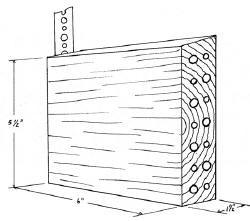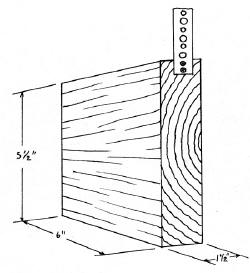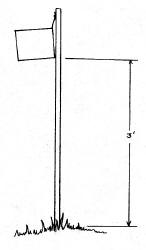301-Field Conservation Management of Native Leafcutting and Mason Osmia Bees
Fact Sheet No. 301, UMaine Extension No. 2420
Fact Sheet Prepared by C. S. Stubbs, Assistant Scientist; F. A. Drummond, Associate Professor; and D. E. Yarborough, Extension Blueberry Specialist, The University of Maine, Orono, ME 04469. March 2000. Acknowledgment: Research for this Fact Sheet was in part funded by Sustainable Agriculture Research and Education (SARE) Producer grants awarded to S. E. Kelly and R. Hammond. Photo Credits: Figure 1 Photo, L. Mayer and A. Stubbs; Figure 2 Photo, S. L. Allard; Figure 3 Photo, L. Mayer and A. Stubbs; Figure 4 Drawings, K. Bosse’.
Introduction
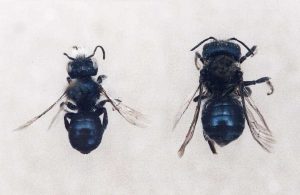
Native leafcutting and mason bees, collectively called megachilids (pronounced mega kyle’ lids), are important pollinators of blueberry and cranberry, Vaccinium spp., in Maine. Field and flight cage studies conducted at the University of Maine have shown that the leafcutting Maine blueberry bee (Osmia atriventris; pronounced 0z’ mee uh Ah truh’ ven tris), is an excellent pollinator of wild blueberry.
Figure 1 shows the male and female Maine blueberry bee. Pollen collecting megachilid females are easily recognized as they are the only bees that carry the pollen on the underside of their abdomen. Megachilids, which literally means “big jaws,” get their name from the fact that they have strong jaws for cutting leaves and other plant material or for digging or collecting mud. The females use this material in the construction of nests for their offspring.
Unlike honey bees and bumble bees, megachilid bees are solitary so they do not live in colonies. Thus each female needs her own nest sites. In nature, females nest in such places as raspberry and blackberry canes, sumac, and in the holes made by other insects in dead trees and wooden fences. There are not enough natural nest sites, which limits the size of their populations. Our research has shown that you can increase megachilid bee numbers in your blueberry fields by providing them with wooden blocks for them to nest in. Figure 2 shows Osmia on a wooden bee nesting block.
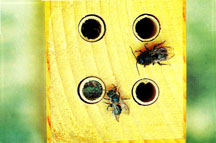
Note the lower left tunnel in Figure 2 is sealed with a leaf plug, which indicates a completed nest. Bee conservation is becoming increasingly important, particularly as the price of commercially available pollinators increases.
This Fact Sheet will provide information on Osmia biology and two important ways you can conserve and increase their populations. First, you can encourage the growth of certain plants along field borders. Second, you can construct and set out wooden bee nesting blocks.
Description and Biology
In Maine, the megachilids important in pollinating blueberry all belong to the genus Osmia. Throughout the wild blueberry growing regions of Maine, nine different species of Osmia that pollinate wild blueberry have been reared from wooden nesting blocks. Seven species, including Osmia atriventris, are leafcutting species, which cap their nests with masticated (thoroughly chewed) plant material. The other two Osmia species use mud to cap their nests and hence are known as mason bees.

The species found in Maine generally are some shade of metallic blue. The only exception is Osmia inermis, which is a nonmetallic black. In Maine, the species range in size from 1/4 to 2/3 inch (7 to 16 mm). Figure 3 shows several species of Osmia bees. Osmia over-winter as dormant adults. Beginning in late April, they begin to emerge from their nest sites.
Males typically emerge before females and are smaller than females. Mating occurs from early to mid-May. In coastal and more northern inland growing areas, emergence and mating may continue until late May. In general, the adult pollinating season of these bees occurs at the same time as blueberry bloom.
Female bees will begin nest construction several days after mating. Often their overwintering site of emergence is reused.
When females collect nectar and pollen from wild blueberry flowers for provisioning their nests, they pollinate the crop. Males contribute slightly to pollination when they visit flowers for nectar, but males do not collect pollen or assist in nest construction.
Female Osmia lay a single egg on a nectar-pollen loaf-shaped provision, then seal the cell with a thin partition of masticated plant material or mud. It takes from 11 to 20 trips to blueberry flowers to complete one cell. A single female may lay as many as 32 to 35 eggs. Eggs hatch into larvae which feed on the nectar-pollen provision in their cell. They then go through a nonfeeding pupal stage and by mid-fall have developed into dormant adults which will then emerge the following spring.
Parasites, predators, and disease can reduce the number of adults emerging the following season. For example, adult female parasitic Sapyga (sa pi jah’) wasps may enter uncapped nests and lay their eggs, which develop faster than Osmia. The wasp larvae kill the developing bees.
Plants to Encourage Along Blueberry Field Borders
Encouraging the growth of certain plants along your field borders will conserve and enhance Osmia populations.
Because some Osmia emerge a bit earlier than blueberry bloom and some live longer than blueberry bloom, the bees will need additional sources of nectar and pollen in order to achieve good reproduction. Females also need young, tender deciduous leaves for nest construction. Our research has found that the plants listed in Table 1, when found along field border, will increase Osmia numbers in your field.
| Table 1. Recommended forage plants for enhancing populations of Osmia spp. | |||
| Common name | Genus | Common name | Genus |
| Before and during blueberry bloom | During and/or after blueberry bloom | ||
| birch maple oak poplar, aspen willow |
Betula Acer Quercus Populus Salix |
aster cherry dogwood, bunchberry honeysuckle sheep laurel, lambkill |
Aster Prunus Cornus Lonicera Kalmia |
Construction, Placement, and Maintenance of Wooden Bee Nesting Blocks
Placing wooden bee nesting blocks around blueberry field borders is an effective, inexpensive means of increasing Osmia bees in your field.
Materials needed. Wooden bee nesting blocks can be made from soft or hardwoods. Maple blocks last the longest and do not readily split, but cost more to make. We have had good success using pine and spruce 2 x 6s. The only other materials needed are metal 3/4-inch strapping tape (also called plumber’s tape), screws for fastening the strapping tape to the back of the blocks, and nails to attach the wooden bee nesting blocks to tree trunks or stakes.
Although using tree trunks involves less construction time and costs, there are two major advantages to attaching the wooden bee nesting blocks to stakes. First, our research indicates that more bee nests are made in wooden bee nesting blocks that are on stakes. Second, fewer nests by other insects and spiders are made in wooden bee nesting blocks on stakes. A relatively inexpensive alternative to tree trunks is to use 10-foot ceiling strapping, cut into 3.3-foot lengths or use saplings for the stakes.
Bee nest block construction. Saw the 2 x 6 into 5-to 6-inch lengths. If, for example, you use 8-foot-long 2 x 6s and make 6-inch long wooden bee nesting blocks, you can get 15 wooden bee nesting blocks from each 2 x 6.
Using a 5/16-inch drill bit, drill 12 to 14 holes into the front of each block. Each hole, (or tunnel as they are called) should be drilled to a depth of 4.75 to 5.75 inches. Be careful not to drill completely through the block because the adult female bees will not nest in tunnels that are open at both ends.
If you want to provide good nesting for the larger species of Osmia as well as for the Maine blueberry bee, we recommend that half of the tunnels in each nesting block be drilled with a 7/16-inch drill bit.
Also, larger blocks with more tunnels per block are not recommended because they are more noticeable to parasites and predators.
Cut the plumber’s tape into 3-inch lengths. Screw the piece of plumber’s tape 1-inch from the top on the center of the back of the wooden bee nesting block. The tape should extend two inches from the top of the wooden bee nesting block. Careful not to screw through a tunnel! The design for the front and back of a completed wooden bee nesting block using two nest tunnel diameters is shown in Figure 4.
Figure 4. Design for wooden bee nesting block and its set-up on a wooden stake (Three figures, above).
Preventing nest dry out. If green wood is used, then the outside and inside of each wooden bee nesting block must be sealed with varnish or polyurethane. Otherwise, as the wood becomes seasoned, it will remove moisture from any nests that the bees have made. Nest dry out will kill the bee eggs and larvae. If you use thoroughly seasoned wood, application of varnish or polyurethane is unnecessary.
Bee nest block placement. Mid-March to late April is the best time to set the blocks out in the field because Osmia bees emerge and start searching for nest sites in May.
If you place blocks on tree trunks around the perimeter of your field, a height of 3.5 to 5.5 feet above the ground is recommended.
If you are using stakes, blocks should be a height of 3 feet above the ground. The top of the block would be level with the top of a 3.3-foot stake (see Figure 4). Blocks on stakes can be placed around and/or in the field. If blocks are placed in the field, you will need to move them prior to pruning. Also, if you harvest with a mechanical harvester, the blocks would need to be moved prior to harvest. Best results are obtained for blocks on stakes by gently moving the stakes with attached blocks to a safe relatively sheltered area or to a field that will be in bloom next spring. Stakes must be kept upright to prevent rodents from destroying the nests.
Blocks should be hung at a slight downward angle to prevent rain from flooding them. They should face into the field and be spaced about 10 to 25 feet apart around the forested field perimeter or windbreaks. Osmia bees do not fly great distances so the blocks need to be relatively near suitable leaf material for their nests. A 20-acre field with 800 feet of forested border, for example, should have from 32 to 54 blocks in order to ensure good nesting success.
Checking for nests. Although the bees are busy pollinating and building nests at the onset of blueberry bloom, generally evidence of nesting is not apparent until late bloom. Then you can easily see where the nests are because those tunnels are capped with masticated plant material or mud. Each capped tunnel may contain as many as 16 offspring. Under ideal conditions, each female is capable of producing approximately 30 to 36 bees. Freshly made nest caps by leafcutting bees begin as bright green but darken with age so that, by autumn, nest caps are grayish brown or almost brown-black.
Maintenance and replacement. Wooden nesting blocks, like tractors and sprayers, are equipment, and equipment needs periodic maintenance to give best results. Softwood blocks generally last four to five years, hardwood blocks much longer. Blocks need to be checked at least twice a year; in the fall and in the early spring. If any wooden nesting blocks have fallen off the trees or stakes, simply reattach them. If you burn the field, care must be exercised so that the blocks are not scorched. Those on stakes can be easily moved if necessary. Blocks with bee nests should not be stored indoors during the winter unless the temperature can be continuously maintained at 34 to 38o F (2 to 3o C). Exposure to temperatures above 38oF (3o C) will cause the bees to emerge from the nest block too early.
Woodpeckers and songbirds sometimes prey on the bees and can damage the nesting blocks. Always remove any damaged blocks. Also, realize that the presence of falcons and hawks should reduce the likelihood of these bird-related problems.
Spiders, some ants, and beneficial wasps also use the wooden bee nesting blocks for shelter and nest sites. From mid-to-late summer, leafcutting megachilids in the genus Megachile, which use whole pieces of leaf or flower petals (in contrast to masticated plant material of Osmia) to cap their nests, will also use the nest blocks. Usually, it is not until the third year of use, that competition for tunnels becomes noticeable. When more than half of the tunnels are capped with materials other than masticated leaf or mud, it is time to add new nesting blocks to those already in the field.
Selected Osmia Bee References
Argall, J., K. MacKenzie, S. Javorek, G. Chiasson, and B. Savoie. 1998. “Native Bees Which Pollinate Blueberry.” New Brunswick Department of Agriculture, Spring 1998.
Javorek, S., K. MacKenzie, and D. Rogers. 1996. Bee Pollinators of Apple and Blueberry in Nova Scotia. Nova Scotia Department of Agriculture, May 1996.
Information in this publication is provided purely for educational purposes. No responsibility is assumed for any problems associated with the use of products or services mentioned. No endorsement of products or companies is intended, nor is criticism of unnamed products or companies implied.
© 2000
Call 800.287.0274 (in Maine), or 207.581.3188, for information on publications and program offerings from University of Maine Cooperative Extension, or visit extension.umaine.edu.
The University of Maine is an EEO/AA employer, and does not discriminate on the grounds of race, color, religion, sex, sexual orientation, transgender status, gender expression, national origin, citizenship status, age, disability, genetic information or veteran’s status in employment, education, and all other programs and activities. The following person has been designated to handle inquiries regarding non-discrimination policies: Director of Equal Opportunity, 101 Boudreau Hall, University of Maine, Orono, ME 04469-5754, 207.581.1226, TTY 711 (Maine Relay System).

